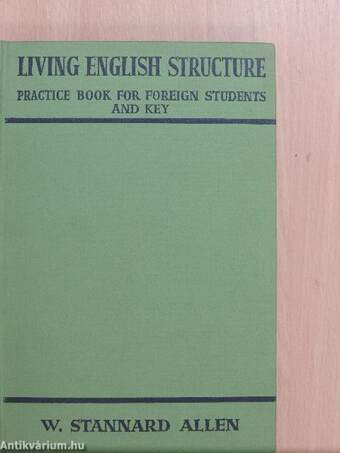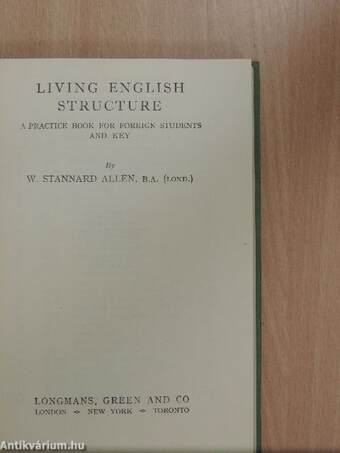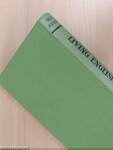1.062.132
kiadvánnyal nyújtjuk Magyarország legnagyobb antikvár könyv-kínálatát

VISSZA
A TETEJÉRE
JAVASLATOKÉszre-
vételek
Living English Structure
A Practice Book For Foreign Students and Key
| Kiadó: | Longmans, Green and Co Ltd |
|---|---|
| Kiadás helye: | London |
| Kiadás éve: | |
| Kötés típusa: | Fűzött kemény papírkötés |
| Oldalszám: | 361 oldal |
| Sorozatcím: | |
| Kötetszám: | |
| Nyelv: | Angol |
| Méret: | 19 cm x 13 cm |
| ISBN: | |
naponta értesítjük a beérkező friss
kiadványokról
naponta értesítjük a beérkező friss
kiadványokról
Előszó
INTRODUCTION
The common problems of English language structure have to be overcome by all students, and the difficulties they find are similar in all parts of the world. Regional differences can... Tovább
Előszó
INTRODUCTION
The common problems of English language structure have to be overcome by all students, and the difficulties they find are similar in all parts of the world. Regional differences can always be dealt with by the teacher, who should be aware of the particular problems of his students. The following general principles are self-evident:
1. All students want to speak, write and read the normal accepted English of today.
2. This can only be achieved by constant practice of existing forms, witji some rational explanation of the grammatical devices employed, wherever this is possible.
The exercises in this book have been devised over a period of eight years, and are the results of practical experience with classes of foreign adults, including students of Latin, Teutonic, Slavonic, and Arabic origin. All the exercises have been tried out and found practicable, and I hope they will prove useful and valuable to many other teachers of English.
How the book should be used
This book is an attempt to answer the foreign student's grammatical problems empirically, and to give him a large number of appropriate exercises to practise them. An English schoolboy does "grammar" as an analytical exercise, but the foreign student needs to learn the mechanics of the language. Most existing grammar books are designed for the English schoolboy, and even a large number of those that are intended for foreigners have not managed to free themselves entirely from the purely analytical point of view.
Teachers will find in this book a great deal that is unconventional, perhaps even revolutionary, for it does not pretend to tell the student what he Ought to Say in English, but tries to show him what Is Actually Said. Many of the exercises are based on the results of personal "structure-counts"—in
vii Vissza
Tartalom
CONTENTS
Subject-Matter of Exercises (Alphabetical Index at back) Section Exercise No- Page
1 1-8 Countable and uncountable nouns 1
2 9-10 Negatives and questions (elementary) 8
3 11-13 Possessive pronouns 9
4 14 "Self" . . 10
5 15 Advefb order 11
6 16-19 Pronouns, case of . 13
7 20-21 Possessive case . 17
8 22 Introduction to interrogatives 19
9 23 Telling the time 20
10 24-25 94Too" and "enough" . 20
11 26-29 "Some" and "any" 22
12 30-33 "No" and "not any" forms . 26
13 34-35 Comparisons 30
14 36-38 Negatives and questions with auxi-
liary verbs 31
15 39 Causative use of " Have " 35
16 40-44 "Must," "have to", "need" . 36
17 45-46 "Can," "could," "was able," etc. . 45
18 47 Short-form negative (revision) 49
19 48-67 Responses using auxiliary vert« 50
20 68-72 Imperative 67
21 73-82 Present tense . 70
22 Notes on English tenses 80
23 83-90 Present Perfect tense 83
24 91-94 Past tense (elementary) 93
25 95-96 Frequency (or pre-verb) adverbs 98
26 97-105 Past tense (continued) . 101
27 106-111 Tense (Revision I) 110
28 112-135 Future and Future Perfect 116
29 136-138 Past Perfect tense 145
V
vi
CONTENTS
Section Exercise No. Pagt
30 139-141 Tense (Revision II) 148
31 142-152 Conditionals and Unreal Past 152
32 153-156 Question-tags 163
33 157-160 " Get" and " got" forms 168
34 161-162 Predicative "so" and "not" . 173
35 163-164 "Do" and "make" 175
36 165 Infinitive particle . 177
37 166-168 "Else" and "or else" . 178
38 169-172 Infinitive 182
39 173-176 Gerund, and other "-ing" forms 186
40 177-178 Infinitive and gerund 192
41 179-180 Perfect infinitive of Imaginary past 197
42 181-186 Verb as noun or adjective 200
43 187-188 Verb-noun with "have" or "take" 201
44 189-198 Interrogatives 202
45 199-201 Interrogative responses . • 212
46 202-211 Relatives 216
47 212-217 Interrogative and relative links 237
48 218 Emphatic connectives ("-ever"
forms) 242
49 219-220 Emphatic colloquial interrogatives . 245
50 221-225 "There is" and "it is" . 247
51 226-242 Reported Speech 252
52 243-246 Passive voice 275
53 Miscellaneous exercises . 284
247-248 "Much," "many," etc., in affirmative 284
249-250 "Also," "too," and "as well" 286
251 "Might just as well," "would just as
soon,'' '" would rather " 287
252 " Certainly " and " surely " . 289
253-255 "Fairly" and "rather" 290
54 256-258 Phrase openings 295
55 259-261 The comparison game . . 299
56 262-265 Prepositions and adverbial particles 301
67 266-268 Accepted phrases 318
Key to exercises * 327
Index . 357
Témakörök
- Idegennyelv > Idegennyelvű könyvek > Angol > Nyelvészet
- Nyelvészet > Idegen nyelvek > Tanulása
- Nyelvészet > Idegen nyelvek > Nyelvtana
- Idegennyelv > Nyelvtanulás > Nyelvtanítás > Nyelvkönyv
- Idegennyelv > Nyelvtanulás > Nyelvek > Angol > Leíró nyelvtan
- Idegennyelv > Nyelvtanulás > Nyelvek > Angol > Gyakorlatok
- Idegennyelv > Nyelvtanulás > Nyelvek > Angol > Tankönyvek > Általános nyelvkönyvek, egyéb
- Tankönyvek, jegyzetek, szöveggyűjtemények > Nyelvtanulás > Angol > Általános nyelvkönyvek, egyéb











